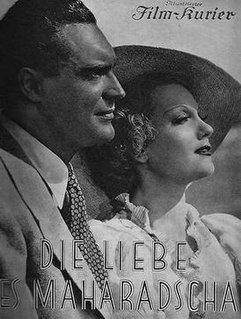Related Research Articles

Westfront 1918 is a German war film, set mostly in the trenches of the Western Front during World War I. It was directed in 1930 by G. W. Pabst, from a screenplay by Ladislaus Vajda based on the novel Vier von der Infanterie by Ernst Johannsen. The film shows the effect of the war on a group of infantrymen portrayed by an ensemble cast led by screen veterans Fritz Kampers and Gustav Diessl.

Gustav Diessl was an Austrian artist, and film and stage actor.

The White Hell of Pitz Palu is a 1929 German silent mountain film co-directed by Arnold Fanck and G. W. Pabst and starring Leni Riefenstahl, Gustav Diessl, Ernst Petersen, and World War I flying ace Ernst Udet. Written by Arnold Fanck and Ladislaus Vajda, the film is about a man who loses his wife in an avalanche while climbing the Piz Palü mountain, and spends the next few years searching the mountain alone for her body. Four years later he meets a young couple who agree to accompany him on his next climb. The White Hell of Pitz Palu was filmed on location in the Bernina Range in Graubünden, Switzerland. The 1929 theatrical release starred Kurt Gerron, who was Jewish, as a night club guest. The film was edited to remove scenes featuring Gerron, and it was rereleased as a 90-minute German-language sound film in 1935. It was remade in 1950.

The Devious Path is a 1928 German silent drama film directed by G. W. Pabst and starring Gustav Diessl, Brigitte Helm and Hertha von Walther. The film's sets were designed by the art directors Otto Erdmann and Hans Sohnle. Location shooting took place at the Markgrafentheater Erlangen in Bavaria. It was made by the German subsidiary of Universal Pictures. It premiered at the Marmorhaus in Berlin.

The Tiger of Eschnapur is a 1938 German film directed by Richard Eichberg and starring Philip Dorn, La Jana and Theo Lingen. It was followed by a second part The Indian Tomb which was released the same year.

Suzy Vernon (1901–1997) was a French film actress. Vernon was born Amelie Paris in Perpignan in Southern France. She began her screen career in 1923 during the silent era and went on to appear in just under fifty films. She generally played the female lead, although she occasionally also appeared in supporting roles.

Demon of the Himalayas is a 1935 German-Swiss co-production adventure film directed by Andrew Marton and starring Gustav Diessl, Erika Dannhoff, and Günter Oskar Dyhrenfurth. It is part of the Mountain film genre which was popular during the era.

Women on the Edge is a 1929 German silent drama film directed by Georg Jacoby and starring Gustav Diessl, Elga Brink and Inge Landgut. Paul Hörbiger notably played the part of a Jewish Impresario Siegfried Nürnberger.

Clarissa is a 1941 German romance film directed by Gerhard Lamprecht and starring Sybille Schmitz, Gustav Fröhlich and Gustav Diessl. Schmitz plays the domineering manager of a bank who eventually falls in love with one of the other employees.
Men Behind Bars is a 1931 American Pre-Code drama film directed by Pál Fejös and starring Heinrich George, Gustav Diessl and Egon von Jordan. It is the German language version of MGM's The Big House. In the early years of sound before dubbing became widespread, it was common to make films in multiple languages. It premiered in Berlin on June 24, 1931.

Nights in Port Said is a 1932 French film directed by Leo Mittler and starring Renée Héribel, Gustav Diessl and Oskar Homolka.
Crooks in Tails is a 1927 German silent film directed by Manfred Noa and starring Nils Asther, Suzy Vernon and Paul Heidemann. A sound film with the same title was released in 1937.
Three Around Edith is a 1929 German silent film directed by Erich Waschneck and starring Camilla Horn, Jack Trevor and Gustav Diessl.

A Mother's Love is a 1929 German silent drama film directed by Georg Jacoby and starring Henny Porten, Gustav Diessl, and Paul Henckels.

Shadows of the Past is a 1936 Austrian drama film directed by Werner Hochbaum and starring Luise Ullrich, Gustav Diessl and Lucie Höflich.

Hans in Every Street is a 1930 German crime film directed by Carl Froelich and starring Hans Albers, Camilla Horn, and Betty Amann. A separate French-language version was also released.

The Appeal to Conscience is a 1949 German mystery film directed by Karl Anton and starring Karl Ludwig Diehl, Werner Hinz and Gustav Diessl. It was originally shot in 1944, but remained uncompleted until it was finished by DEFA in the post-war era. It remained unreleased until it was given a 1949 premiere in Austria. Subsequently it was distributed in East Germany in 1950 and West Germany in 1951.

The Green Emperor is a 1939 German crime film directed by Paul Mundorf and starring Gustav Diessl, Carola Höhn and René Deltgen. It was inspired by the real-life case of a Belgian financier who had gone missing during a flight across the English Channel.

The Love of the Maharaja is a 1936 German drama film directed by Arthur Maria Rabenalt and starring Gustav Diessl, Attila Hörbiger and Hilde von Stolz.</ref> It was made as a co-production between the Italian Astra Film and the Munich-based Bavaria Film. A separate Italian version A Woman Between Two Worlds was also produced.
In Thrall to the Claw is a 1921 Austrian silent film directed by Carl Froelich and starring Eugen Jensen, Gustav Diessl, and Julius Strobl. While visiting the set, future director Georg Wilhelm Pabst made his only ever screen appearance as an actor.
References
- ↑ Grange, William (2008). Cultural Chronicle of the Weimar Republic. Lanham, MD: Scarecrow Press. p. 190. ISBN 081085967X. LCCN 2008008116.